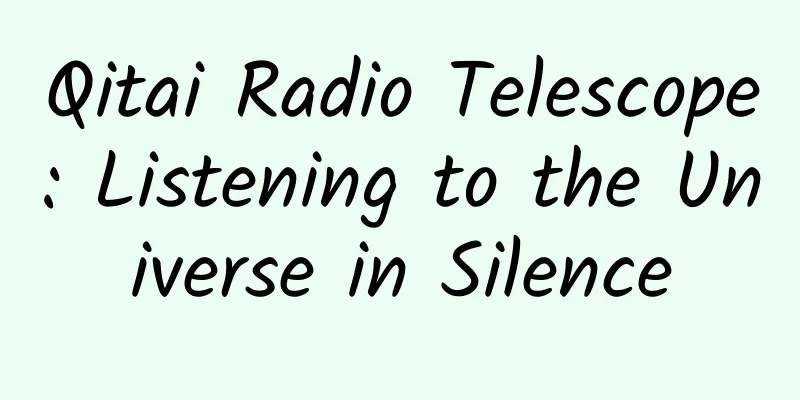Qitai Radio Telescope: Listening to the Universe in Silence

|
Produced by: Science Popularization China Author: Ma Yingxiu and Liu Qi (Xinjiang Astronomical Observatory, Chinese Academy of Sciences) Producer: China Science Expo In life, humans use their ears to listen to sounds and understand what is happening in the outside world through sounds. On Earth, there is another kind of "ear" that can listen to the sounds of the universe, which is the radio telescope . Radio telescopes have very high requirements for the "home" they live in and the surrounding environment. Why is this? The big ears that listen to the universe - radio telescopes Radio telescopes can help humans listen to the "voice" of the universe and reveal the mysteries of the universe. However, compared with the signals on Earth, the cosmic signals received by radio telescopes are very weak. For example, as of now, even if the energy of the signals received by all radio telescopes on Earth is added together, it is still not as strong as the energy of a leaf falling to the ground. In order to listen to such weak radio signals, the Big Ear radio telescope has very strict requirements on the electromagnetic noise in the surrounding environment, just like we cannot hear the sound of a needle falling to the ground in a noisy environment. Urumqi Nanshan 26m Radio Telescope (Photo source: Xinjiang Astronomical Observatory) Finding Home: Solving the Problem of Housing Radio Telescopes What kind of home is suitable for a radio telescope? Astronomers traveled around the world to find a suitable home for the radio telescope. Finally, this home was found in Shihezi Village, Banjiegou Town, Qitai County, Xinjiang. The owner of this place, the QiTai radio Telescope (QTT), officially laid its foundation and started construction on September 21, 2022, attracting the attention of the global astronomical community. QTT groundbreaking ceremony (Photo source: Xinjiang Astronomical Observatory) Let’s take a look at the home of the Qitai Radio Telescope! Shihezi Village in Banjiegou Town, Qitai County, Xinjiang is picturesque, with blue sky above, snow-capped mountains in the distance, and grasslands underfoot. The Qitai radio telescope is located in this basin surrounded by mountains on three sides. The natural mountains block the radio signals and electromagnetic noise outside the mountains and also reduce the wind speed. The climate here is dry, with many sunny days and little light pollution. In layman's terms, this is the "pure land" of radio telescopes, with a quiet electromagnetic noise environment. QTT Station Site (Photo source: Xinjiang Astronomical Observatory) Uninvited guests - jamming radio telescope signals Although the Qitai radio telescope has found a suitable home, this is only the first step. Before a built radio telescope can obtain high-quality observation data, there will be many "uninvited guests" who will interfere with the radio telescope. What are these "uninvited guests"? Is there any way to deal with them? (1) Space wireless communication services, such as civil or military satellite communications, radar, and aviation wireless communication services. These radio signals are difficult to eliminate, but we can use some technical means to figure out the location of the device transmitting the signal, the operating frequency band, the operating time and other related parameters, analyze the impact of the signal on astronomical observations, and develop efficient observation methods to avoid observations during certain periods. We can also use data processing methods to reduce the impact of radio signals on astronomical observation data. Radar and satellite equipment (Photo source: veer photo gallery) (2) Ground wireless communication services, such as mobile communications, radio and television, microwave relay, high-voltage power transmission systems and other fixed/mobile wireless communication services. To deal with this type of interference, only sites with less radio signals can be selected, and radio quiet zones should be established. Different management requirements are put forward for different areas in the quiet zones. For example, in the wireless quiet zone of the Qitai Radio Telescope (see the figure below), the core area (a rectangular area of 2.5 km from east to west and 4 km from north to south) prohibits the installation and use of any radio stations, and strictly prohibits the construction of facilities that radiate electromagnetic waves; restricted areas and coordination areas also have clear construction and management requirements. Interference signals from wireless communications, high voltage towers (Photo source: veer photo gallery) QTT Radio Quiet Zone (Photo source: Xinjiang Astronomical Observatory) (3) You may not know that vehicles, mobile phones, walkie-talkies, digital cameras, smart wearables and other personal electronic devices also have varying degrees of electromagnetic radiation, which can also affect radio astronomy observations. Control the carrying and use of such electronic devices, such as turning off the wireless function of the device or shutting it down. Interference signals from mobile phones, vehicles, etc. (Photo source: veer photo gallery) (4) During the construction and operation of radio telescopes, various electronic devices will generate electromagnetic radiation of different frequency bands when they are working, such as various computer network equipment, motors and control systems used when the telescope rotates, surveillance cameras, lighting, air conditioning, office equipment, etc. in the station, and even microwave ovens used in the cafeteria have strong electromagnetic radiation. The radiation emission noise of these devices is unavoidable in the construction of the telescope itself and the station. For this kind of interference, there are specialties in the field. Xinjiang Astronomical Observatory has a professional electromagnetic compatibility technology team that is studying the measurement and mitigation methods of various signals. Interference signals from air conditioners, microwave ovens, cameras, etc. (Image source: veer Gallery) The "magic weapon" to deal with interference sources-electromagnetic compatibility technology In order to provide a better "living" environment for large radio telescopes, scientists have explored many anti-interference technologies, among which electromagnetic compatibility technology is one of the effective ways to deal with interference sources. The electromagnetic compatibility of large radio telescopes needs to rely on multiple links, including various electromagnetic interference detection, signal statistics and feature analysis, signal wave propagation and coupling analysis, electromagnetic protection and electromagnetic compatibility design, to reduce the adverse effects of various radio signals around the telescope site and the radiation emissions of its own electronic equipment on radio astronomical observations. To shield electromagnetic interference, we must first know the source and characteristics of the signal, and we also need a mature electromagnetic interference detection system and electromagnetic compatibility evaluation system. The electromagnetic compatibility team of Xinjiang Astronomical Observatory has developed a multi-scenario electromagnetic interference detection system , which is applied to scientific research areas such as Nanshan Station, Qitai Station and the National Time Service Center. At the same time, the scientific research team has also built an electromagnetic compatibility evaluation system for large radio telescopes, solving the electromagnetic compatibility control and evaluation technology problems of large radio telescopes. Highly sensitive, fully automated electromagnetic environment monitoring system (Photo source: Xinjiang Astronomical Observatory) Xinjiang Astronomical Observatory Darkroom Environment Electromagnetic Compatibility Measurement and Evaluation System (Photo source: Xinjiang Astronomical Observatory) Secondly, in response to the radiation emission interference from the telescope itself and the electronic equipment on the site, the electromagnetic compatibility technology team of the Xinjiang Astronomical Observatory proposed a low-cost building shielding method, which uses stainless steel wire mesh to isolate the radiation noise of electronic equipment inside the building, reducing the impact of the radiation emission noise of electronic equipment inside the building on astronomical observations. At present, this method has been applied to 6 buildings at the Qitai radio telescope site. Testing has shown that its shielding effectiveness is significant, thus solving the technical problem of shielding difficulties in large buildings. Process plan and shielding device development (Photo source: Xinjiang Astronomical Observatory) Building shielding solution application (Photo source: Xinjiang Astronomical Observatory) At present, the Qitai radio telescope that has found its "home" is under construction, and the project contract has been signed and the bidding for the antenna active surface system has been completed. Related technical exchange activities and infrastructure construction are also in full swing. Listen to the universe in silence——You and I are the guardians of radio telescopes It is not easy to find a good site for a radio telescope, and it is even more difficult to maintain a good radio environment for a long time after finding it. Compared with natural electromagnetic interference, the interference caused by human beings is more significant. While engineers are working hard to reduce signal interference, each of us who are close to the radio telescope should consciously abide by the electronic equipment management regulations. For example, employees and visitors on the site are prohibited from using digital cameras, game consoles, walkie-talkies, WiFi and other electronic devices and wireless transmission devices. Let us work together to protect the radio environment so that radio telescopes can perform their duties in the "pure land" that belongs to them! |
<<: The rights and wrongs of "white people's rice"
Recommend
Kashgar Mini Program Agency, how much does it cost to be an agent for a lighting mini program?
What is the price of being an agent for the Kashg...
How to do Baidu bidding promotion? Learn these tips to quadruple your results!
I believe everyone is familiar with Baidu bidding...
General tips for excellent Weibo advertising | There is always one optimization of these 26 details that can reduce costs!
Three principles of image matching 1. Prioritize ...
How do we “see” the brightest “fireworks” in the universe?
On October 9, 2022, there was a very shocking and...
Example analysis: How does Love Bank APP achieve user fission?
The user fission of Love Bank is very ingenious. ...
Say goodbye to rejection, how to improve iOS review pass rate (Part 1)
iOS review has always been a huge challenge for e...
China Passenger Car Association: Analysis of the national passenger car market in July 2019
1. Review of the national passenger car market in...
WeChat Android 8.0.18 beta version update: Added iOS-like practical features such as write-while-translate, and the ability to manually turn off live streaming push notifications
After nearly two months, WeChat finally released ...
Setting many world records! The world's tallest fully floating Lingdingyang Bridge was successfully completed
◎ Science and Technology Daily reporter Jiao Yang...
Finding a needle in a haystack! New discoveries in the universe
A research team composed of American and European...
Zhihu App product operation experience analysis report!
From a niche elite community to a knowledge mento...
The "giant" that captures sunlight draws the "green miracle" of Ulan Buhe
In the vast national territory, desert control an...
Chasing dreams and asking the sky: Revelations from China's 30 years of manned space flight
On February 24, the "Dreaming of the Univers...









